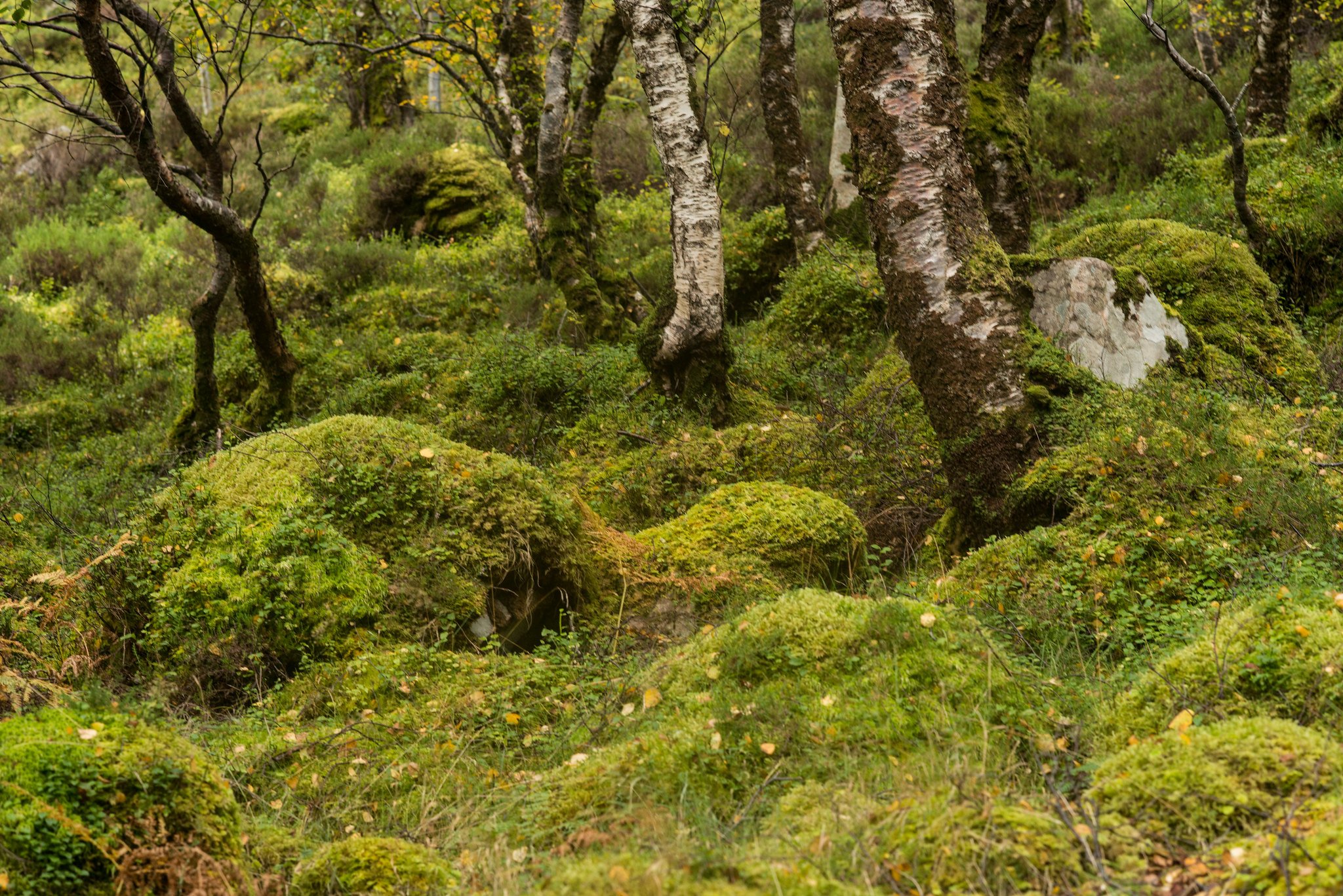The trees of Scotland’s rainforest
Scotland’s rainforest wouldn’t exist without trees.
It might be what’s growing under, on, over and around the trees that makes the habitat so special and rare. But if the trees go, then most of the mosses, liverworts and lichens that depend on them would also vanish, along with the other plants, insects, birds, and mammals, that make up the rainforest’s incredible biodiversity.
Rainforest woodlands are very variable. Some are dominated by single tree species, while others are more mixed. Many are classified as ancient, which (in Scotland) means they’ve existed continually as woodland since at least 1750. But that doesn’t mean they haven’t been managed in some way. Many woodlands found in the rainforest zone were used historically for timber, charcoal production or as shelter for stock over winter. Despite that human intervention, and indeed because of it in some locations, the trees have survived, leaving the woodlands we see today.
No two areas of rainforest are exactly alike, and this variety of habitat is great for lichens and bryophytes (mosses and liverworts). Different species and ages of trees have different types of bark: smooth, rough, pitted, peeling, acidic, and that affects what can grow on them. Some areas of woodland are also particularly wet or exposed, which changes the types of trees that will grow there.
Here are five you’re likely to come across:
Birch
The most common tree in Scotland’s rainforest zone is the birch, and there are three main types: silver, downy or mountain. It’s common because birch trees are a pioneer species that can quickly spread into new areas. They produce a huge quantity of tiny seeds, which travel far and wide on little ‘wings’. Any seedlings that find a good place to grow are then often ignored by grazing animals like deer (maybe they taste bitter?) so birch are more likely to survive and grow into young trees.
Birch trees are important for wildlife, as they support lots of invertebrates, and are great for nesting birds. Many birds also eat their seeds, and you’ll sometimes see big flocks of redpolls or siskins dangling amid the thin branches as they feast. Birch trees also play host to several species of fungi, like the birch polypore, and fly agaric can often be found growing near to birch trees in the autumn.
Oak
Although birch is the most common tree in Scotland’s rainforest, oak woodlands are also incredibly important and make up around a fifth of the total area of remaining rainforest. Many oakwoods were historically managed for charcoal or to produce tannin, which was used in the leather industry. In these oakwoods, seedlings of other tree species were often removed to let the oaks thrive, which it why the species became so dominant.
Oak trees play a massive role in supporting biodiversity and play host to thousands of different species of plants, invertebrates, birds and mammals, some of which depend on the oaks completely for survival. Their acorns, for example, are an important food source for squirrels and jays, both of which like to bury the nuts as a stash of food for winter, helping the oaks to spread. Purple hairstreak butterflies, wood warblers and many species of lichens, mosses and liverworts also depend on the oak trees of Scotland’s rainforest.
Ash
Ash trees are fast growing and one of the easiest trees to identify in winter because of their black, burnt-looking leaf buds. You’ll find ash growing in mixed areas of woodland in the rainforest, where it spreads through winged seeds that can travel quite far on the wind. Its Gaelic and Norse names (uinsinn and ask) turn up in place names all over the west of Scotland, showing just how important this tree has been through history. It still has many uses today and is often considered one of the best woods to burn, as it doesn’t need to be seasoned.
Ash trees are important in woodland because their leaves appear late and fall early, allowing lots of light to reach the forest floor and creating ideal conditions for many woodland plants. But ash trees are also under threat from ash dieback, a fungal infection that kills younger trees and terminally weakens older ones. The disease was first recorded in the UK in 2012 and has now spread across much of Scotland. Sadly, there’s not much that can be done to prevent ash dieback, but there is some advice for the public here: www.forestresearch.gov.uk/tools-and-resources/fthr/pest-and-disease-resources/ash-dieback-hymenoscyphus-fraxineus/
Hazel
Hazelnuts may be a staple of the Christmas nut bowl, but the trees they grow on are often overlooked. That may be because hazels don’t usually form big, impressive ‘trees’ but rather grow as multiple stems more like a shrub, though these can still get quite large. People have long used the hazel for coppicing, cutting the stems back to the ground to make use of the wood, but the trees grow like this quite naturally. Hazel often forms a very dark woodland, which makes it hard for other plants to establish, and its dense stems can also be a barrier for larger browsing mammals, like deer.
Scotland’s Atlantic hazelwoods are very special habitats and are certainly the oldest woodlands in the rainforest, with some stands perhaps several thousand years old. Because they’ve often grown undisturbed for such a long time, these woodlands create an ideal environment for slow-growing lichens and bryophytes to form. Several species of lichen are specialists of Scotland’s hazelwoods and are found in few other places. The white script lichen is found nowhere else on the planet.
Scots pine
Scotland’s rainforest is usually associated with deciduous trees, except for non-native invaders like the Sitka spruce. But individual Scots pines are often found in mixed areas of rainforest, and there are two pine woodlands, at Beinn Eighe and Ben Shieldaig in the far north west, that are made up of Scots pines that have entirely adapted to growing within the rainforest zone.
It’s easy to think of the Scots pine as a rare tree, but it’s actually the most widespread conifer in the world. It’s quite distinctive, with its sculptural shape, and orangey-red bark, and as a tall tree it often sticks out in a mixed woodland. Its seeds and leaf buds are an important source of food for birds and red squirrels, and like other areas of rainforest, its bark can host many lichens, mosses and liverworts.
Other trees of Scotland’s rainforest
Of course, there are many more native trees to find in Scotland’s rainforest, including: alder, aspen, elder, elm, hawthorn, holly, lime, juniper, rowan, sycamore, willow and wych elm.
Not sure of your birch from your hazel? Download this free and easy to use Tree ID app for your next rainforest ramble: Identify Trees With Our Tree ID app - Woodland Trust







